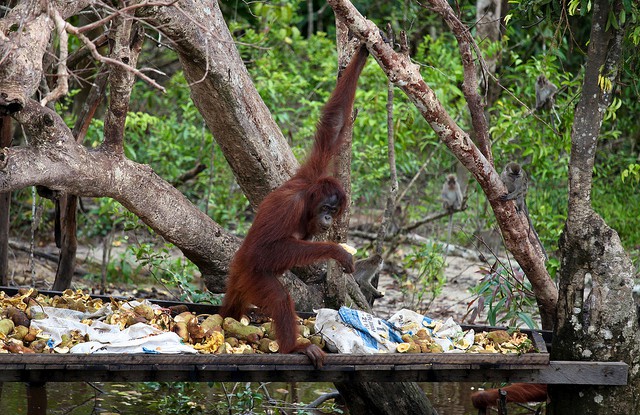
BOGOR, Indonesia (2 September 2013) – Biodiversity conservation projects created to save endangered great apes could also play a key role in poverty alleviation if local communities stand to benefit, according to researchers.
Chimpanzees, orangutans, bonobos and gorillas live in some of the poorest regions of Africa and Asia, and they are fast losing their forest habitats to such human activities as hunting, logging, agriculture and mining.
Territorial incursions related to forest fire, oil palm plantations, war and conflict are also putting pressure on great apes, which number from a few hundred to a few tens of thousands, depending on the subspecies, statistics from the World Wild Fund for Nature (formerly World Wildlife Fund) conservation body show.
“Reshaping international policies that protect both great apes and the livelihoods of people living alongside them are critical to finding a positive outcome for both,” said Terry Sunderland, a senior scientist with the Center for International Forestry Research (CIFOR).
“As pressures grow on tropical forests, policymakers need to craft development policy to balance great apes conservation and biodiversity in general.”
Although humans and great apes shared the same forests for tens of thousands of years in relative peace, increasing human populations, poverty, and a decrease in availability of natural resources have led to conflict, Sunderland said.
Many great apes are protected in high-security conservation areas that can restrict poor local communities from accessing much-needed food and other subsistence livelihood supplies, he added.
In addition, local communities often do not benefit financially from great ape conservation-linked tourism.
POLICY SHIFT
One means of establishing equilibrium between often competing interests of human development and great ape conservation would be to encourage development projects under the global REDD+ (Reducing Emissions from Deforestation and Forest Degradation) mechanism, Sunderland said.
REDD+ is a climate change mitigation scheme that aims to encourage the reduction of greenhouse gas emissions by creating incentives to conserve, restore and sustainably manage forests.
In both Asia and Africa, the practice of replanting forest habitats and creating related jobs, could help meet REDD+ targets, according to the new research summarized in a paper titled “Linking conservation and poverty alleviation: A discussion paper on good and best practice in the case of great ape”.
In Africa, great ape tourism pulls in high revenues – in Uganda, for example, gorilla permits generate more than $4 million a year, the paper said, citing Akanwasah Barirega from Uganda’s Ministry of Tourism, Wildlife and Antiquities.
Conservation areas hire trackers and guides, while ticket sales and supporting accommodation and service industries can benefit the local economy.
The downside of the tourism industry is that it can make great apes more susceptible to poaching, crop-raiding and other forms of conflict with humans, the report said, adding that economic risks to poor people are high when great apes raid crops, but conversely, human hunting and capture of great apes harms conservation efforts.
“Many great apes, including the majority of wild orangutans in Sumatra and Borneo – chimpanzees in many African countries – live in unprotected habitats where land-use change and increasing population growth can increase conflict,” Sunderland said.
For more information on the issues discussed in this article, please contact Terry Sunderland at t.sunderland@cgiar.org or Dilys Roe at dilys.roe@iied.org
This research is carried out as part of the CGIAR Research Program on Forests, Trees and Agroforestry.
We want you to share Forests News content, which is licensed under Creative Commons Attribution-NonCommercial-ShareAlike 4.0 International (CC BY-NC-SA 4.0). This means you are free to redistribute our material for non-commercial purposes. All we ask is that you give Forests News appropriate credit and link to the original Forests News content, indicate if changes were made, and distribute your contributions under the same Creative Commons license. You must notify Forests News if you repost, reprint or reuse our materials by contacting forestsnews@cifor-icraf.org.